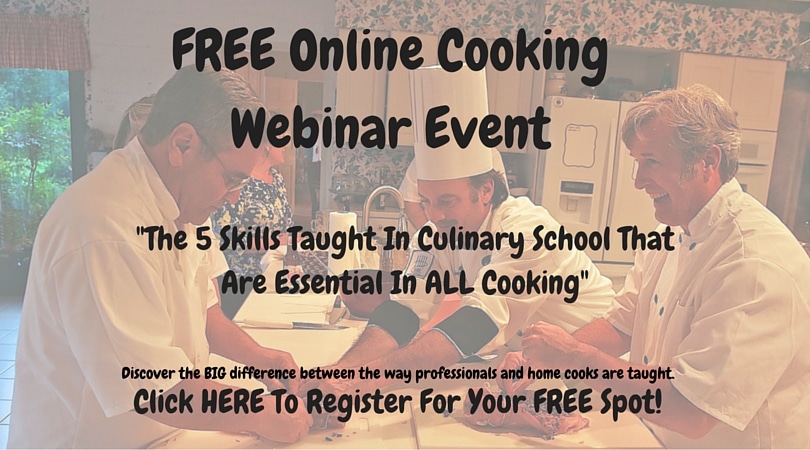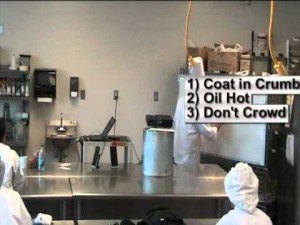You can fry in a pan or sauté on the stove top, but knowing the differences between the two methods is an important lesson in cooking college. There are big differences between the basic cooking methods of Pan Frying and Sauté.
Since we’ve already covered the two types of heat for cooking in another class, immediately my cooking college class can point out the first major difference.
Sauté is a conductive cooking process, meaning the heat is directly applied through the sauté pan and a SMALL amount of fat to help conduct it. Items cook very quickly during a stove-top sauté, following the progression of temperatures outlined in the lesson called “How Does Food Cook”?.
When you apply heat directly to food, as in sauté, proteins stiffen and shrink. Then, moisture evaporates as the product dries out. Lastly, sugars start to caramelize and the product turns brown. Under sauté, these steps can happen very quickly.
But, take the product and fry in a pan with enough oil to cover it three-quarters of the way up and you’ve changed the cooking method from direct to indirect heat. You’ve changed from conductive heat to convective heat.
It’s our job at the cooking college at which I teach, to examine how food reacts under different exposures to heat. A professional chef is never surprised at the outcome of cooking. He or she understands and controls the heat to their desires.
During pan frying, the fat or oil is the medium to transfer the heat. Now, with an indirect cooking process, the effects of the heat will be different than sauté. It’s a lower temperature and slower time method of cooking.
The best advantage of stove top cooking in hot oil is the texture you can develop. Items cooked this way are usually brown and crispy. The crunchy texture is because pan fried items are most often coated in flour or crumbs to retain moisture and create a barrier from the hot oil.
These are the other two major differences saute and pan frying. Items to be sauteed are not usually coated in crumbs and use a small amount of oil. Otherwise, coat the item in crumbs and submerge it in hot oil and you’ve got something that’s been pan fried.
Our 6 Step Fry In A Pan Procedure:
1) Coat the item to be fried in some type of crumbs or cracker meal. This ingredient is entirely up to you. Whether you choose Japanese Panko, bread crumbs, saltine crackers, graham crackers, or potato chips, the crumb must be used in a three-step breading procedure.
– Coat the dry raw item in seasoned flour. The flour sticks to the food.
– Dredge the item in beaten egg. The egg sticks to the flour.
– Bread the item in your chosen crumbs. The crumbs stick to the egg
2) Heat your oil. The best result of an item pan fried is a golden crunchy crumb. If your oil is too cold, the product will marinate in fat and slowly come up to cooking temperature. This will leave you with a soggy coating. If your oil is too hot, the crumb will burn before the interior cooks.
The best way to tell if your oil is hot enough to cook is with a thermometer and heated to about 350F. Otherwise, you can take a pea-sized piece of your crumbs and drop it into the hot oil. If it immediately bubbles, races around the pan and starts to brown, your oil is ready. If the oil begins to smoke at any point, quickly lower the heat to avoid imparting burnt tastes.
3) Don’t overcrowd the pan. Since this is a convective cooking process, where the heat is transferred by the oil, then the oil must be touching all sides of each product. If you crowd a pan of breaded pork chops and let them touch, you’ll have raw spots where they didn’t cook.
4) Cook 75 percent on the first side. Just like a sauté procedure, you want to be able to witness the changes in the product. If you flip a pan fried item too quickly, you’ll just be looking at a brown item and loose all those indicators of whether it’s done or not.
5) Use your thermometer to tell when it’s done. A finished internal temperature of 165F (74c) is the best target for food cooked this way. However, if you notice that your dish is getting too brown in the pan, but is not at the correct temperature yet, you can change the cooking process. Remove the item from the hot oil and finish cooking it in the oven where it will not brown as quickly.
6) Let the item rest and drain. When your thermometer tells you it’s done, remove the item and let it rest like a steak. Placed on a rack for optimal air circulation, the juices will redistribute and any excess oil will drain. This is a better technique than placing a pan fried item on a paper towel because the contact can make the crumb mushy by steam from the item.
Just because your pork chop will fry in a pan instead of roast in the oven doesn’t mean you can’t take a lesson from cooking college. There is a standard procedure to each of the basic cooking methods, that when duplicated consistently, can take your cooking from fair to professional!
Discover the difference between how professionals and home cooks are taught in my next
FREE Webinar Workshop
Claim your FREE Spot for the next webinar session by CLICKING HERE



Chef Mohr has one of the best deliveries in teaching that I have ever seen. He uses his inate humorus style to drive home his points of cooking. The idea of breaking away from recipes is different and maybe revolutionary because it allows personal creativity along with freedom of all kinds like having to make several unnecessary trips to the grocery….use what you have is his motto. His is a drastic new way to cook! it’s exciting!
Thanks for the kind words, Bob. I’m glad you find my approach exciting. The smartest people always do! It’s so much more liberating to cook in a way that you want instead of what the TV or cookbook tells you. There’s an entire world of food and cooking methods to explore out there!
I’m 87 and have been cooking since I was 13 years old. I thought I knew everything about preparing food, but you’ve opened my eyes to fine-tuning the “basics” for which I’m very grateful. As you do, I find that I don’t need a lot of recipes to make dishes that tickle the nose with their aromas, please the eye with plating and enjoying the food and listening to favorable comments from family and friends. Thanks.
Andrea
Wow! What a great compliment, Andrea. I find the best cooks are the ones that “just throw things together”. While there is no actual throwing of food, what the statement means to me is that these people know the methods and are able to express their own desires or artistic interpretation through them.
The best cooking instructors in the world are Grandmothers. I hope you’re passing some of your great knowledge onto the next generation.
Thanks for taking the time to share such a nice comment.